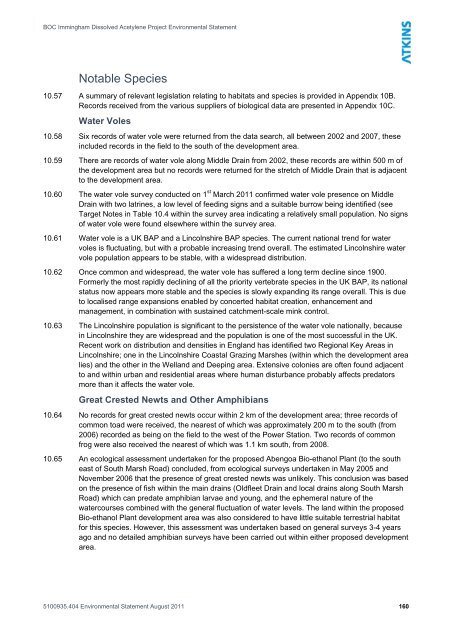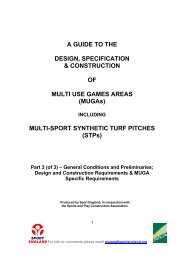View - North East Lincolnshire Council
View - North East Lincolnshire Council
View - North East Lincolnshire Council
You also want an ePaper? Increase the reach of your titles
YUMPU automatically turns print PDFs into web optimized ePapers that Google loves.
BOC Immingham Dissolved Acetylene Project Environmental Statement<br />
Notable Species<br />
10.57 A summary of relevant legislation relating to habitats and species is provided in Appendix 10B.<br />
Records received from the various suppliers of biological data are presented in Appendix 10C.<br />
Water Voles<br />
10.58 Six records of water vole were returned from the data search, all between 2002 and 2007, these<br />
included records in the field to the south of the development area.<br />
10.59 There are records of water vole along Middle Drain from 2002, these records are within 500 m of<br />
the development area but no records were returned for the stretch of Middle Drain that is adjacent<br />
to the development area.<br />
10.60 The water vole survey conducted on 1 st March 2011 confirmed water vole presence on Middle<br />
Drain with two latrines, a low level of feeding signs and a suitable burrow being identified (see<br />
Target Notes in Table 10.4 within the survey area indicating a relatively small population. No signs<br />
of water vole were found elsewhere within the survey area.<br />
10.61 Water vole is a UK BAP and a <strong>Lincolnshire</strong> BAP species. The current national trend for water<br />
voles is fluctuating, but with a probable increasing trend overall. The estimated <strong>Lincolnshire</strong> water<br />
vole population appears to be stable, with a widespread distribution.<br />
10.62 Once common and widespread, the water vole has suffered a long term decline since 1900.<br />
Formerly the most rapidly declining of all the priority vertebrate species in the UK BAP, its national<br />
status now appears more stable and the species is slowly expanding its range overall. This is due<br />
to localised range expansions enabled by concerted habitat creation, enhancement and<br />
management, in combination with sustained catchment-scale mink control.<br />
10.63 The <strong>Lincolnshire</strong> population is significant to the persistence of the water vole nationally, because<br />
in <strong>Lincolnshire</strong> they are widespread and the population is one of the most successful in the UK.<br />
Recent work on distribution and densities in England has identified two Regional Key Areas in<br />
<strong>Lincolnshire</strong>; one in the <strong>Lincolnshire</strong> Coastal Grazing Marshes (within which the development area<br />
lies) and the other in the Welland and Deeping area. Extensive colonies are often found adjacent<br />
to and within urban and residential areas where human disturbance probably affects predators<br />
more than it affects the water vole.<br />
Great Crested Newts and Other Amphibians<br />
10.64 No records for great crested newts occur within 2 km of the development area; three records of<br />
common toad were received, the nearest of which was approximately 200 m to the south (from<br />
2006) recorded as being on the field to the west of the Power Station. Two records of common<br />
frog were also received the nearest of which was 1.1 km south, from 2008.<br />
10.65 An ecological assessment undertaken for the proposed Abengoa Bio-ethanol Plant (to the south<br />
east of South Marsh Road) concluded, from ecological surveys undertaken in May 2005 and<br />
November 2006 that the presence of great crested newts was unlikely. This conclusion was based<br />
on the presence of fish within the main drains (Oldfleet Drain and local drains along South Marsh<br />
Road) which can predate amphibian larvae and young, and the ephemeral nature of the<br />
watercourses combined with the general fluctuation of water levels. The land within the proposed<br />
Bio-ethanol Plant development area was also considered to have little suitable terrestrial habitat<br />
for this species. However, this assessment was undertaken based on general surveys 3-4 years<br />
ago and no detailed amphibian surveys have been carried out within either proposed development<br />
area.<br />
5100935.404 Environmental Statement August 2011 160




